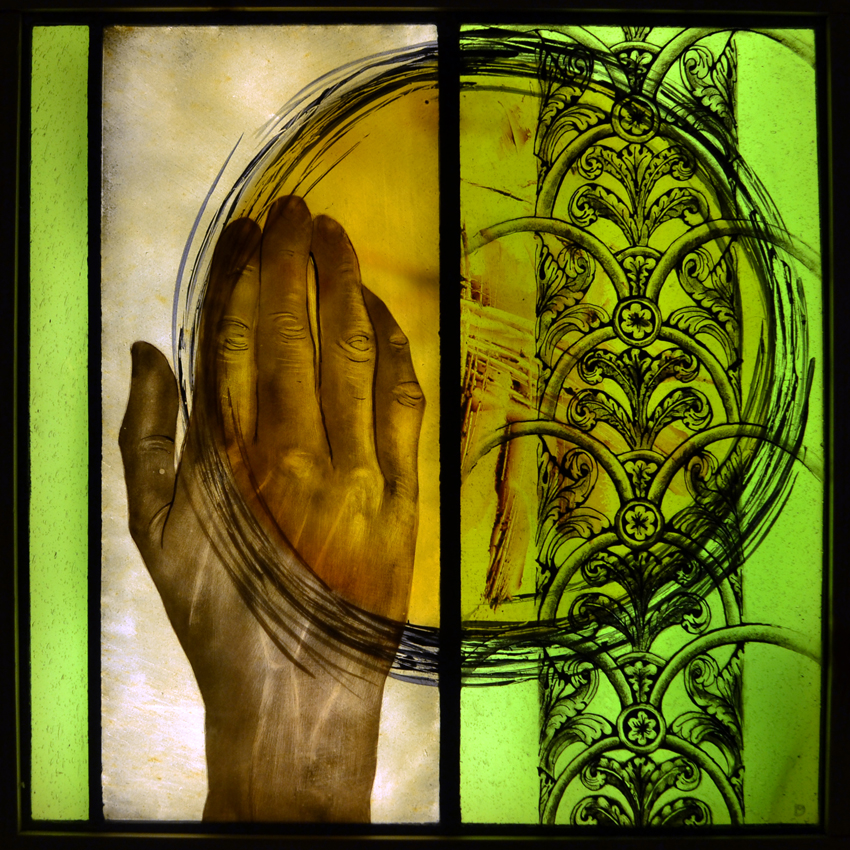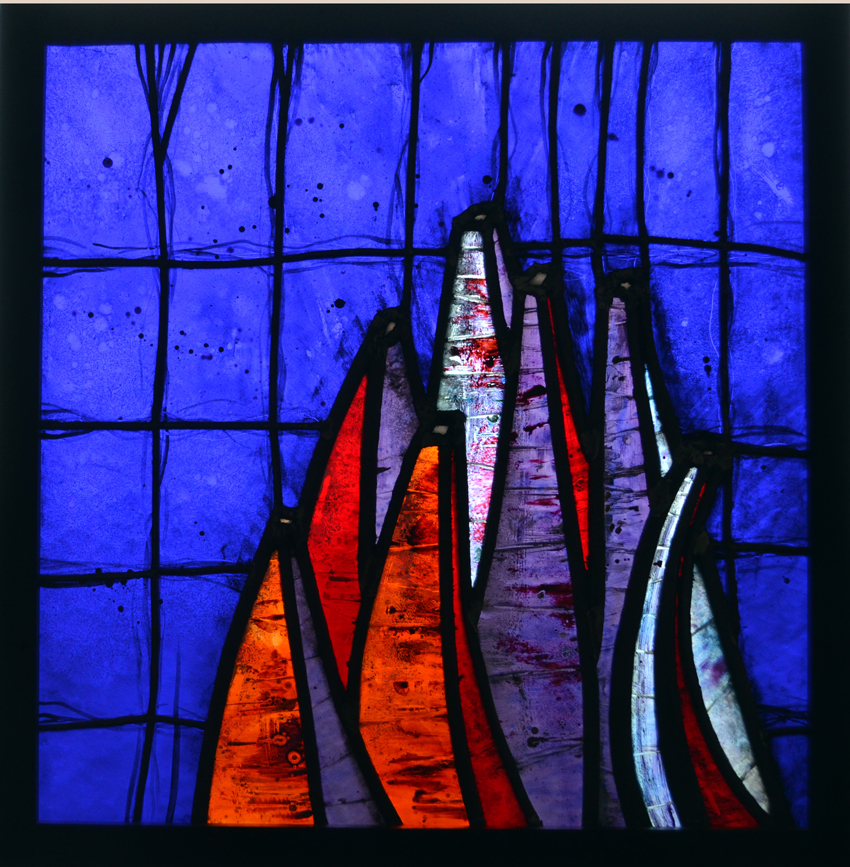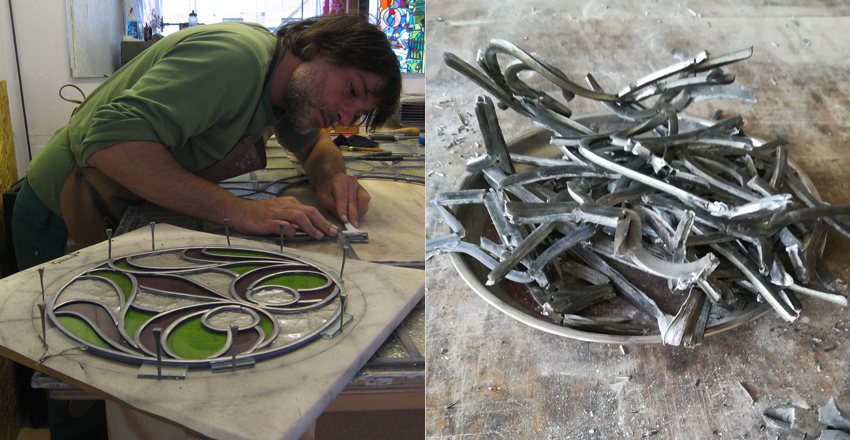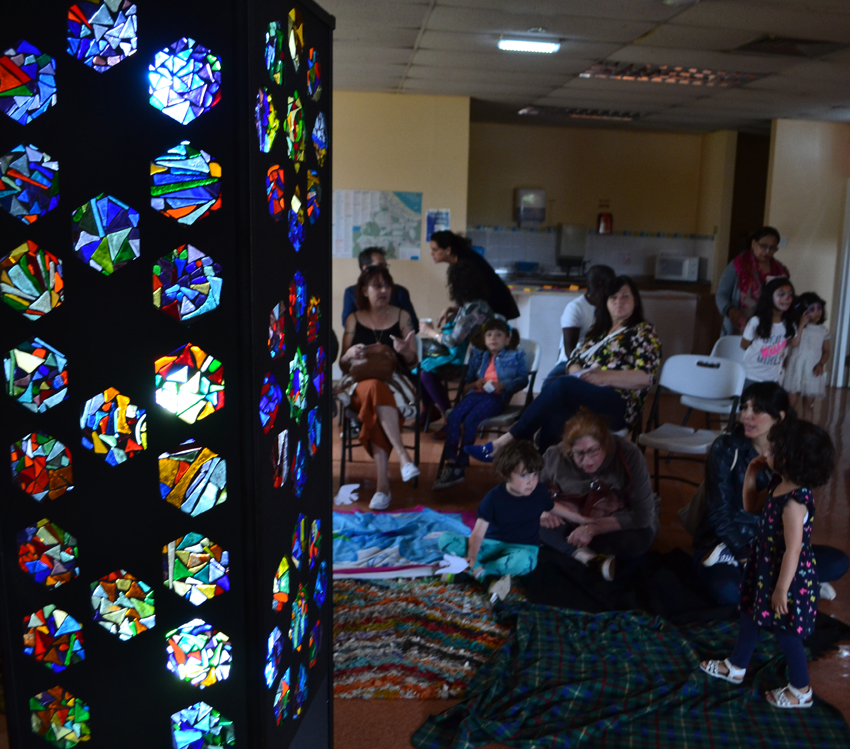In celebration of Scotland’s Climate Week, this post is part of our Make It Green series, for the Green Crafts Initiative (GCI) that champions and promotes environmentally sustainable craft practices. In this series by Craft Scotland and Creative Carbon Scotland, you will hear inspiring maker’s stories as well as useful advice on how you can contribute to a greener craft sector.
We’re pleased to feature makers who are working towards a more sustainable practice. In this interview, you will hear from a maker who is part of the GCI and who is challenging traditional stained glass making with his own sustainable methods.
Hi David, can you tell us about your practice?
David: I am a stained glass maker, born 44 years ago in a glazier shop in southern Spain. The shop was the family business so everyone in the household was involved in some way. It was the 1980s and my favourite task at the time was cutting thousands of small mirrored squares to make disco balls! My fascination with glass started early, and glass has surrounded me ever since.
I studied Stained glass and Glass design at the Centre del Vidre in Barcelona, I also earned a degree in photography and audiovisual communication from the Complutense University of Madrid.
I work predominantly with both stained and bespoke kiln glass. The majority of my work is functional and utilitarian. As such, when I design and manufacture a piece of stained glass, I always have in mind how the light will pass through it, how this will change the atmosphere of the space and how this might affect the work itself as well as the observer.
My inspiration comes from natural imagery, sometimes from very delicate magnified images, sometimes from abstractions coming from nature. All my work is largely influenced by the colours, shapes and pictorial style of medieval stained glass, however, the work is achieved in a contemporary vein.
 Image: David Mola - Maker's Hand traditional stained glass panel / Image by the artist
Image: David Mola - Maker's Hand traditional stained glass panel / Image by the artist
For twelve years, I have managed my own studio where I work on both private and public commissions as well as carrying out research into a variety of glass techniques. Nowadays, I am based in Edinburgh and take commissions for architectural glass, both traditional and contemporary. I also run classes and workshops on stained glass making.
Last year, I co-founded Midas Skills School, an initiative providing independent and professional education for anyone willing to learn art and craft skills.
When and why did you decide to become more sustainable?
Regarding sustainability, things have changed so much in such a short period of time. Being efficient with my use of resources is a very important part of my process, leading me to work in a more natural and sustainable way.
I began learning by looking to the past – reusing and recycling, working with local produce, keeping the human relation between the maker and the user, were all part of a more natural way of working. In my own practice, I am trying to recover this past mode of working because, in my case, working with ancient techniques can be associated with the use of materials that are not so eco-friendly. For example, as a stained glass maker, I use a large amount of lead (as lead can be found in my paints and cements). Modern techniques such as glass lamination might also require the use of epoxy resins.
Learning to work with these types of materials was not just about making sure to use the correct Personal Protective Equipment (PPE). It was also about learning how to dispose leftovers; trialling more efficient ways to use them and the possibilities of replacing them for more eco-friendly materials. Unfortunately, at that time, through my personal learning experience I did not discover much on these matters and for years, this continued to be an issue I was constantly trying to fix in my own studio.
 Image: David Mola - New York leaded panel / Image by the artist
Image: David Mola - New York leaded panel / Image by the artist
However, only a year ago, I discovered the Green Crafts Initiative and thus, decided to tackle this issue more seriously. Having a group of makers working in the same direction, and being able to share tips and knowledge, encouraged me to return to this task.
I had plenty of work to do and processes to change in my daily practice, and at first, I felt a bit overwhelmed. I found it quite difficult to tackle all at the same time. So, I decided to handle each issue one at a time. In this way, step-by-step, I could get closer to the ideal of becoming a more sustainable glass artist.
How do you incorporate eco-conscious thinking into your process? What changes have you made to create a more sustainable practice?
Many of the measures and changes I have made in my practice might seem quite obvious but are in no way less effective. I have gradually been moving from printed leaflets and cards to digital tools - this is a more sustainable and clean method to promote my business, with no extra waste. I do also try to keep part of the designing stage on digital and to use print as and when needed.
At present, I am based in the artist community hub Wasps studios in Edinburgh, together with around 200 more studios in Edinburgh. This provides a great opportunity to find materials in the recycling bins!
Reusing materials is always a must in my practice. Window glass and framing glass sourced from broken frames from my neighbours are welcome in my studio. I use them as part of my pieces and in classes for my students. I am not scrupulous at all when comes to mixing handmade expensive glass with recycled window glass.
Transportation was another key point. I might be one of the few stained glass makers who mainly commutes via cycling. When I do have to install a big panel and need a car or a van to transport, I decide to use rent cars. I joined one of the rent-a-car companies that rent by the hour and that way I have minimised not just the number of cars on our streets but also my expenses on car maintenance.
I continue to work with lead-based glass paint. Although I am aware there is an extensive range of lead-free paint, I am finding it really challenging to make the change to lead-free painting. First of all, I will need time to research and secondly, it is incredibly costly. For these reasons, it is difficult to make the gradual change and to substitute all of your stock for a new one. So, I am waiting for the opportunity to make this change happen, perhaps, I can receive funding in the future to wipe out the use of lead in my work and to afford the costly, yet eco-friendly alternatives.
Conversely, I have become more conscious of my use of lead, disposing offcuts and old lead efficiently to local scrap dealers through collection.
 Image: David Mola (left) lead cementing a fused panel and (right) lead disposal / Photography by Daniel Dabrowski
Image: David Mola (left) lead cementing a fused panel and (right) lead disposal / Photography by Daniel Dabrowski
One of my more beloved technique is glass lamination. For years, I have been working with a special kind of epoxy resin, achieving great results. However, the extensive use of the resin I was handling caused repeated headaches, even when using the right PPE equipment, and problems to dispose leftovers became an issue. After an intensive search, I discovered a substitute: a two compounds silicone used in the electronic industry – a material easier to use and much more sustainable. It took me a long while to discover the peculiarities of the new material, but at the end, the change was a success.
Tell us about the favourite pieces you have made using sustainable methods...
I use my glass offcuts for a variety of purposes like cutting skills classes, mosaic pieces, fused recycled glass classes. Working with the goal of finding new use for my glass offcuts, I fell into a very interesting project earlier this year - a community art project funded by the Edinburgh Council. An inclusive project involving refugees communities in North Edinburgh, primary and secondary schools, as well as older people from migrant backgrounds, surround the celebration of Eid. The idea was to create an art piece based on the traditional gypsum stained glass panels from the Middle East but revisited and adapted to this particular project.
 Image: David Mola Eid celebration community project / Image by the artist
Image: David Mola Eid celebration community project / Image by the artist
Geometrical Islamic art was the main theme. The challenge was how to deliver a series of two-hour workshop for such a variety of participants. Of course, it had to be sustainable and friendly with the area. The final result was a giant lantern (1.80 meters high) with 110 stained glass mosaic pieces made entirely by members of the community. All made with Stockboard (100% recycled farm plastic. Cheap, durable, stable, light and easy to be routed!). The problem of dealing with the sharp edges of glass was dealt with by firing my boxes of offcuts to achieve a smooth collection of bright and very attractive colour beads.
The final piece consisting of 110 mosaics, created by 77 participants from ages 2 to 92 years old, and an event to celebrate with the Islamic community their big annual party, Eid.
What do you think the future of sustainable craft making will look like?
Things change. We are living in times where we have to change the way we consume, the way in which we produce, and the way we connect with each other.
As makers, we share part of the responsibility of that change on the production. We now have more information and knowledge regarding the impact of certain materials and uses. We have that vision of future and how it will impact in the environment, and as well as looking to the past to recover another way to produce and consume more sustainably.
As a small business, I used to think that changes can't be done if it doesn't come from above - from big companies or industries. Now I am convinced that movement starts from the bottom. A small step in the right direction may encourage others to make the same.
“Never doubt that a small group of thoughtful, committed, citizens can change the world. Indeed, it is the only thing that ever has.” Margaret Mead, 1969
For more information on David Mola and his work, please visit his website at https://www.davidmola.com
This interview has been lightly edited for clarity.
 Image: David Mola - Maker's Hand traditional stained glass panel / Image by the artist
Image: David Mola - Maker's Hand traditional stained glass panel / Image by the artist Image: David Mola - New York leaded panel / Image by the artist
Image: David Mola - New York leaded panel / Image by the artist Image: David Mola (left) lead cementing a fused panel and (right) lead disposal / Photography by Daniel Dabrowski
Image: David Mola (left) lead cementing a fused panel and (right) lead disposal / Photography by Daniel Dabrowski Image: David Mola Eid celebration community project / Image by the artist
Image: David Mola Eid celebration community project / Image by the artist